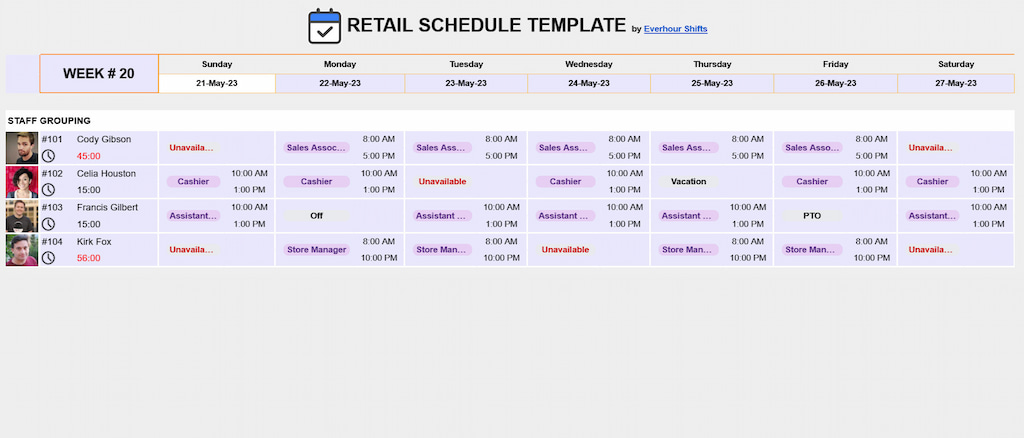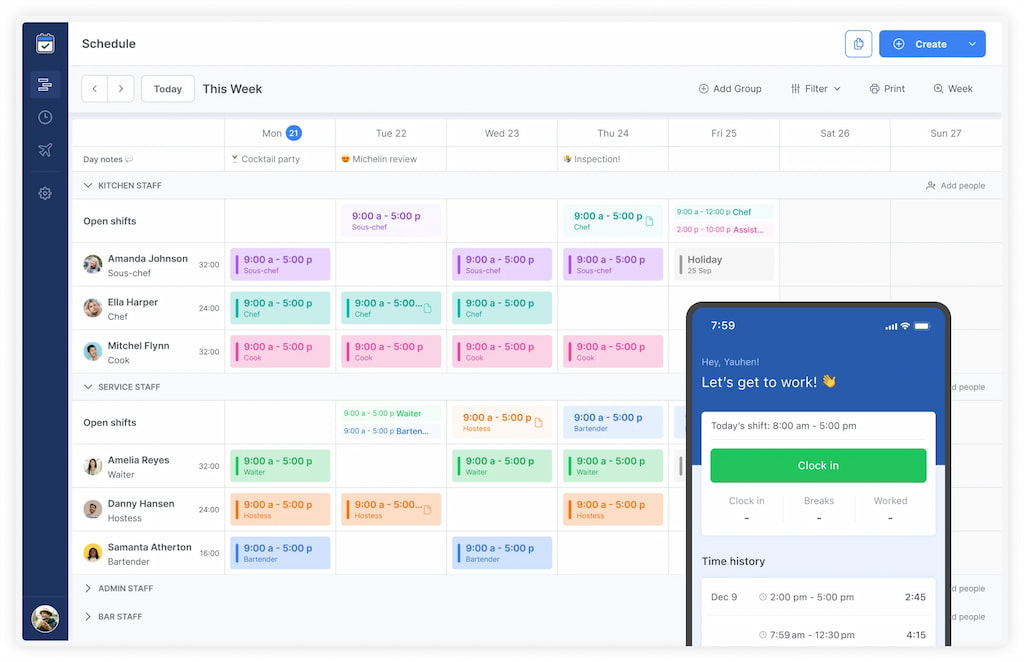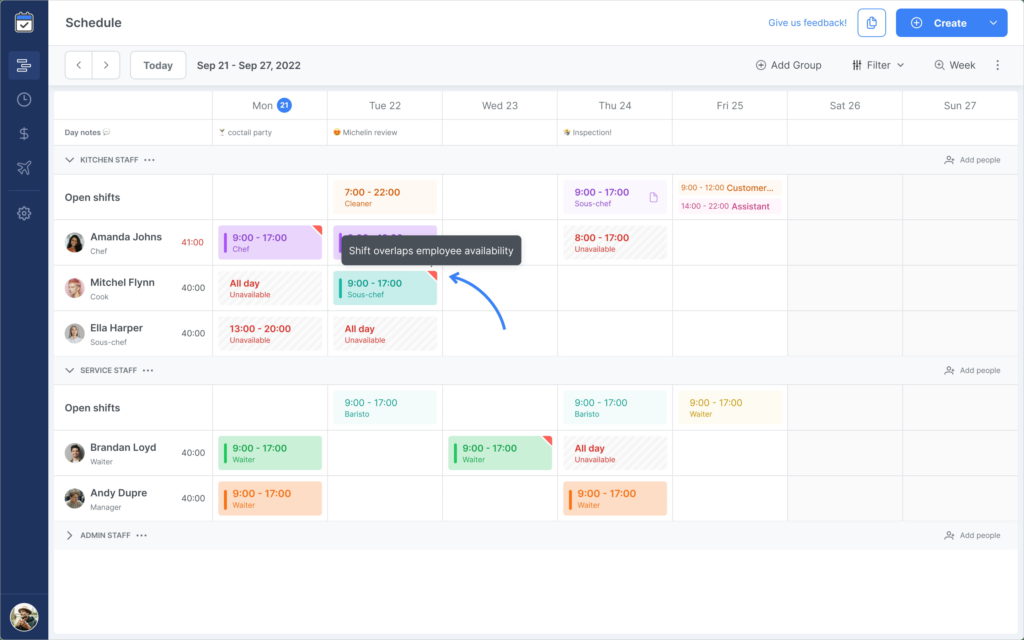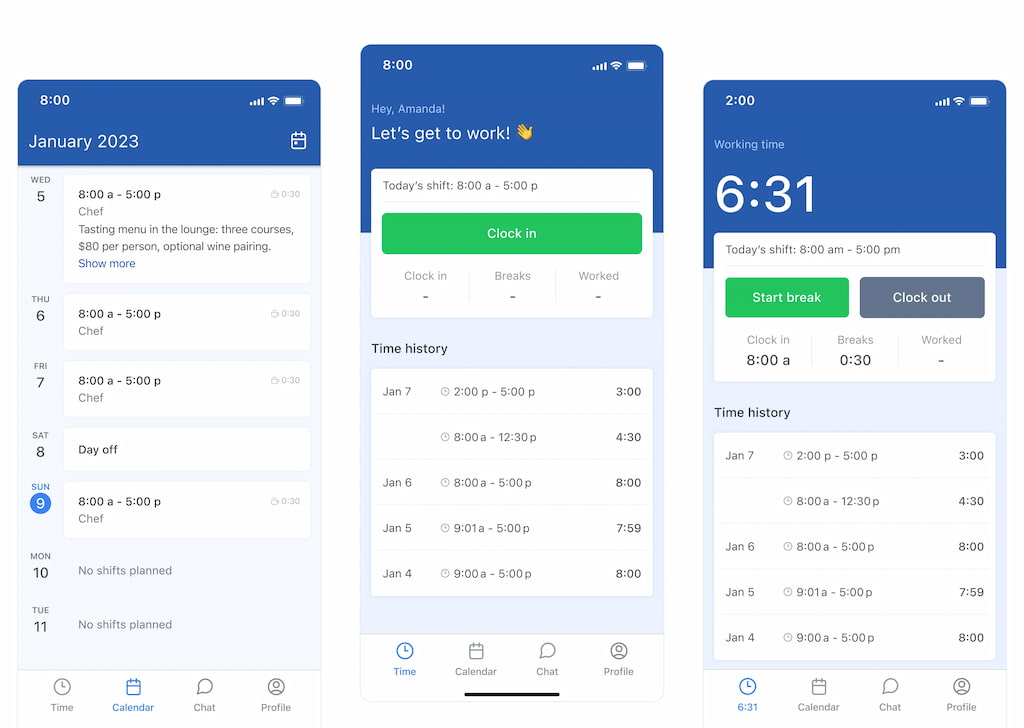Effective retail scheduling is paramount for ensuring smooth operations, optimizing staff productivity, and enhancing customer satisfaction in the fast-paced retail environment. In this article, we’ll delve into retail scheduling best practices, exploring strategies and techniques to streamline scheduling processes, maximize workforce efficiency, and minimize operational challenges. Whether you’re managing a small boutique or a large retail chain, using the best employee scheduling apps and understanding and implementing these best practices can significantly impact your business’s success. Join us as we uncover the key principles and tactics to master the art of retail scheduling.
What is a Retail Schedule?
A retail schedule serves as the blueprint for organizing and managing staffing resources within retail establishments. It outlines the specific shifts, hours, and tasks assigned to employees to ensure adequate coverage across various departments and operational hours.
Retail employee scheduling typically factors in peak business hours, seasonal demands, employee availability, and labor regulations to create an optimized staffing plan.
At its core, a retail schedule aims to balance the needs of the business with the preferences and availability of the workforce, striving to meet customer demand while maintaining employee satisfaction and operational efficiency. It serves as a vital tool for retail managers to allocate resources effectively, minimize labor costs, and deliver exceptional service to customers. The components of a store schedule may include:
- Shift assignments: Designating specific work hours and shifts for employees based on their roles, skills, and availability.
- Task allocation: Assigning tasks and responsibilities to each employee during their scheduled shifts, ensuring all essential duties are covered.
- Break and lunch times: Incorporating break and lunch periods into the schedule to comply with labor regulations and provide employees with necessary rest periods.
- Time off requests: Managing employee time off requests and accommodating them within the schedule while maintaining adequate staffing levels.
- Rotation and coverage: Implementing rotation schedules to distribute tasks evenly among employees and ensure coverage during peak hours and busy periods (like 2-2-3 schedule, 2nd shift hours schedule, or Panama schedule).
Overall, a well-structured retail schedule plays a crucial role in optimizing workforce management, enhancing operational efficiency, and delivering a seamless customer experience in the retail industry.
Top 13 Retail Scheduling Best Practices
Ah, the bustling world of retail – where each day brings new challenges, fresh faces, and the perpetual dance of balancing customer satisfaction with operational efficiency. In this landscape, the heartbeat of success lies in the art of scheduling. Let’s explore these 13 retail scheduling best practices that will revolutionize your approach, streamline operations, and keep your team and customers beaming with delight.
1️⃣ Forecast customer traffic
Forecasting customer traffic is crucial for effective scheduling in retail. You can anticipate busy periods and adjust staffing levels by analyzing historical data and upcoming events. For example, if you know that weekends are typically busier than weekdays, schedule more staff during those times to ensure optimal customer service.
2️⃣ Leverage historical data
Your store’s past sales and foot traffic patterns hold valuable insights for future scheduling decisions. Take advantage of this data to identify trends and patterns, allowing you to allocate resources more effectively. Look for recurring patterns, such as seasonal fluctuations or peak shopping hours, and adjust your schedule accordingly to meet demand.
3️⃣ Embrace flexibility
In the fast-paced world of retail, flexibility is key. Adopt agile scheduling practices that allow for last-minute changes and accommodate employee preferences. Encourage open communication between managers and staff, allowing for adjustments to be made as needed while ensuring that shifts are adequately covered.
4️⃣ Cross-train your team
Building a versatile workforce is essential for maintaining smooth operations in retail. Cross-train your employees across different roles to ensure that they can step in wherever needed. This not only increases efficiency but also empowers employees to take on new challenges and develop new skills.
5️⃣ Utilize technology
Embrace retail scheduling software to streamline your scheduling processes and improve communication with your team. These tools can automate scheduling tasks, track employee availability, and provide real-time updates on shift changes. By leveraging technology, you can save time and ensure that your schedule remains accurate and up-to-date.
6️⃣ Empower employees
Involve your employees in the scheduling process by soliciting their input and preferences. Allow them to express their scheduling preferences and accommodate them whenever possible. This not only increases employee satisfaction but also fosters a sense of ownership and accountability among your team members.
7️⃣ Prioritize work-life balance
Striking a balance between work and personal life is essential for employee well-being and productivity. Create schedules that prioritize work-life balance by offering fair distribution of shifts and adequate rest periods between shifts. Consider implementing policies such as rotating schedules or flexible hours to accommodate employees’ needs.
8️⃣ Communicate effectively
Clear and transparent communication is key to successful scheduling in retail. Ensure that schedules, changes, and expectations are communicated effectively to all team members. Utilize communication tools such as email, messaging apps, or bulletin boards to keep your team informed and engaged.
9️⃣ Monitor and adjust
Regularly monitor schedule performance and gather feedback from your team to identify areas for improvement. Be open to adjusting to your schedule based on feedback and evolving business needs. By staying agile and responsive, you can ensure that your schedule remains effective and efficient.
🔟 Celebrate success
Recognize and reward employees for their contributions to successful scheduling practices. Celebrate achievements and milestones, whether it’s meeting sales targets, maintaining high customer satisfaction scores, or successfully implementing new scheduling initiatives. By acknowledging and appreciating your team’s efforts, you can foster a positive work culture and drive motivation and engagement.
1️⃣1️⃣ Plan your budget
Effective budget planning is essential for successful retail scheduling. Take into account factors such as labor costs, sales projections, and seasonal fluctuations when creating your budget. Allocate resources strategically to ensure that you have adequate staffing levels during peak periods without overspending on labor.
1️⃣2️⃣ Allow shift swapping
Empower your employees to take control of their schedules by allowing shift swapping. Shift swapping allows employees to trade shifts with each other to accommodate personal commitments or preferences. Implement clear guidelines and procedures for shift swapping to ensure that shifts are covered adequately and fairly. Encourage open communication and collaboration among employees to facilitate smooth shift swaps.
1️⃣3️⃣ Utilize a schedule template
Streamline your scheduling process by using a store schedules template as a foundation. A schedule template provides a framework for organizing shifts and ensures consistency across schedules. Customize the template to fit your store’s unique needs, including factors such as employee availability, skill levels, and preferred work hours.

What to Look for in Retail Scheduling Software
When it comes to managing staff scheduling in a retail environment, having the best scheduling software can make all the difference. Here are key features to consider when evaluating retail store scheduling software:
🛠️ Ease of use: Retail environments are fast-paced, and managers need scheduling software that is intuitive and easy to use. Complex or cumbersome software can slow down the scheduling process and lead to errors. Look for software with a user-friendly interface and straightforward navigation to streamline scheduling tasks.
🔄 Employee availability management: In retail, staffing needs can vary greatly depending on factors like seasonality, store location, and sales trends. Employee availability management tools allow managers to efficiently schedule shifts based on employee preferences and availability. This helps ensure that the right staff are scheduled at the right times to meet customer demand.
⏰ Shift scheduling: Flexible shift scheduling options are essential for retail environments where operating hours can vary widely. Drag-and-drop functionality and customizable shift lengths make it easy for managers to create schedules that align with store hours and staffing needs. This flexibility allows for efficient allocation of resources and ensures adequate coverage during peak times.
📢 Communication tools: Effective communication is crucial in retail settings to ensure that all staff are informed of schedule changes, shift updates, and other important information. Built-in communication tools, such as messaging or notification features, enable managers to easily communicate with employees and keep everyone on the same page.
💳 Integration with POS systems: Integration with point-of-sale (POS) systems allows retail managers to better forecast staffing needs based on sales data. By analyzing sales trends and transaction volumes, managers can optimize scheduling to ensure that staffing levels align with customer traffic. This integration also enables more accurate labor cost calculations and budgeting.
📊 Reporting and analytics: Detailed reporting and analytics provide valuable insights into labor costs, employee productivity, and scheduling trends. Retail managers can use this data to identify areas for improvement, optimize workforce management strategies, and make informed decisions about scheduling and staffing.
📜 Compliance and labor law features: Compliance with labor laws and regulations is essential in retail, where labor costs can account for a significant portion of operating expenses. Scheduling software with built-in compliance features, such as automated overtime calculations and break management tools, helps ensure that schedules comply with labor laws and regulations, reducing the risk of costly penalties.
📱 Mobile accessibility: In the fast-paced retail environment, managers and employees are often on the move, making mobile accessibility a key feature of scheduling software. Mobile access allows managers to access schedules, make changes, and communicate with staff from anywhere, ensuring that scheduling tasks can be efficiently managed even when managers are not physically in the store.
How Can Shifts by Everhour Help with Retail Scheduling?
Shifts by Everhour is the best retail scheduling software for seamless and efficient retail scheduling. Here’s how Shifts by Everhour can revolutionize your scheduling process:
Flexible shift management: Shifts by Everhour allows managers to easily create and manage shifts based on store hours, employee availability, and staffing requirements. The intuitive interface and drag-and-drop functionality make it simple to adjust shift schedules as needed, ensuring adequate coverage during peak hours and minimizing understaffing or overstaffing issues.

Employee availability tracking: Staff scheduling in retail often involves juggling multiple employees’ availability preferences and time-off requests. Shifts by Everhour includes features for tracking employee availability, allowing managers to quickly see which staff members are available for upcoming shifts and make scheduling decisions accordingly. This helps reduce scheduling conflicts and ensures that shifts are assigned fairly and efficiently.

Communication tools: Effective communication is essential in retail settings to ensure that all staff members are informed of schedule changes, shift updates, and other important information. Shifts by Everhour includes built-in communication tools, such as messaging and notification features, which enable managers to easily communicate with employees and keep everyone on the same page. This helps prevent misunderstandings and ensures that employees are always aware of their upcoming shifts and responsibilities.
Mobile clock-in/out functionality: Shifts by Everhour’s mobile clock-in/out feature empowers retail employees with the flexibility to conveniently record their work hours using their smartphones or tablets. This feature enables staff members to clock in and out from any location, whether they are on the sales floor, in the warehouse, or on break. For managers, real-time updates on employee attendance facilitate efficient monitoring and timely scheduling adjustments.

Ready to streamline your retail scheduling? Sign up for Shifts by Everhour today and revolutionize the way you manage your workforce!
Retail Scheduling Best Practices: Frequently Asked Questions (FAQ)
❓ What is the importance of retail scheduling in a store setting?
Effective retail scheduling ensures that the right employees are working at the right times to meet customer demand, optimize sales, and maintain operational efficiency. It helps balance staffing levels, control labor costs, and ensure a positive customer experience.
❓ How can I create a retail schedule that meets both business needs and employee preferences?
To create a balanced schedule, consider factors such as peak business hours, employee availability, skill sets, and labor laws. Incorporating employee preferences for shifts and days off can improve morale and reduce turnover.
❓ What are some common challenges faced in retail scheduling?
Common challenges in retail scheduling include managing fluctuating demand, dealing with last-minute changes, balancing employee availability with business needs, and complying with labor regulations.
❓ How can technology help improve retail scheduling practices?
Technology solutions such as scheduling software can automate scheduling processes, provide real-time visibility into staffing levels, facilitate shift swapping and communication among employees, and generate reports for better decision-making.
❓ How often should I review and adjust my retail schedule?
Regularly reviewing and adjusting your schedule is essential to adapt to changing business needs, employee availability, and customer demand. Aim to review and adjust your schedule at least weekly, if not more frequently during peak seasons or when facing significant changes.
If you’re looking for a seamless way to improve shift planning, Shifts by Everhour is the perfect retail employee scheduling software. With features like real-time monitoring, easy scheduling, and mobile accessibility, managing your workforce has never been simpler.

